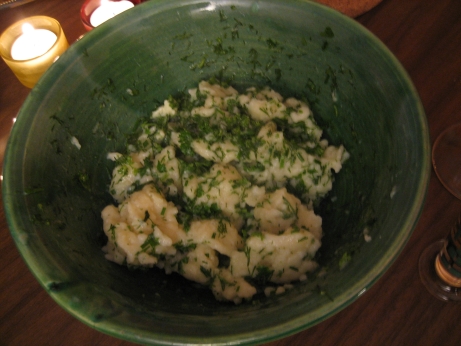
No recipe for this one.
This recipe was a bit of a disaster. As disaster’s go it tasted quite good, but the result bore little resemblance to the recipe description. The Book says
“The tiny drop-style German dumplings called spaetzle are juged by their lightness, and these practically take flight”
My efforts yielded large, dense, and doughy dumplings that no German would have recognized even as a failed attempt at spaetzle. The recipe is fairly simple, a dough of flour, salt, eggs, and milk is lightly brought together. Then the dough is worked through the holes of a colander over a pot of simmering salted water, and the resulting dumplings are boiled for 5 minutes, then tossed with butter, chives, parsley, dill, salt and pepper.
My issue came with getting the dough into the simmering water. I put the dough in the colander which is part of my set of pots. It fits snugly into the top of the pot I had the simmering water going in. I began working the dough through, at first everything was fine, and I made a few 1/4 inch dumplings. As I continued working though, the heat of the simmering water and steam began to cook the dough in the colander, and it gummed up all the holes. I ended up having to force partially cooked stuff through the colander, where it globed together into tablespoon size dumplings for me to scrape off the back. Anyway, I cooked the resultant dumplings longer than recommended, and they were fine, but not spaetzle.
The herb butter was a wonderful compliment to the dumplings, in fact the butter pretty much made the dish. I prepared this during the winter, and I really appreciated having my kitchen perfumed by the herbs as they were tossed with the hot dumplings.
I’m really unsure what went wrong with this recipe, but it just didn’t make any sense the way it was. Maybe the problem was in the shape of my colander? maybe I was supposed to hold the colander mid-air while I pushed the dumplings through? But that seems incredibly awkward. Piping the dumplings into the water would work, but it might be a bit slow. There is such a thing as a spaetzle maker, which I can only presume would do a better job. The poor man’s spaetzle maker suggested here isn’t an adequate substitute.